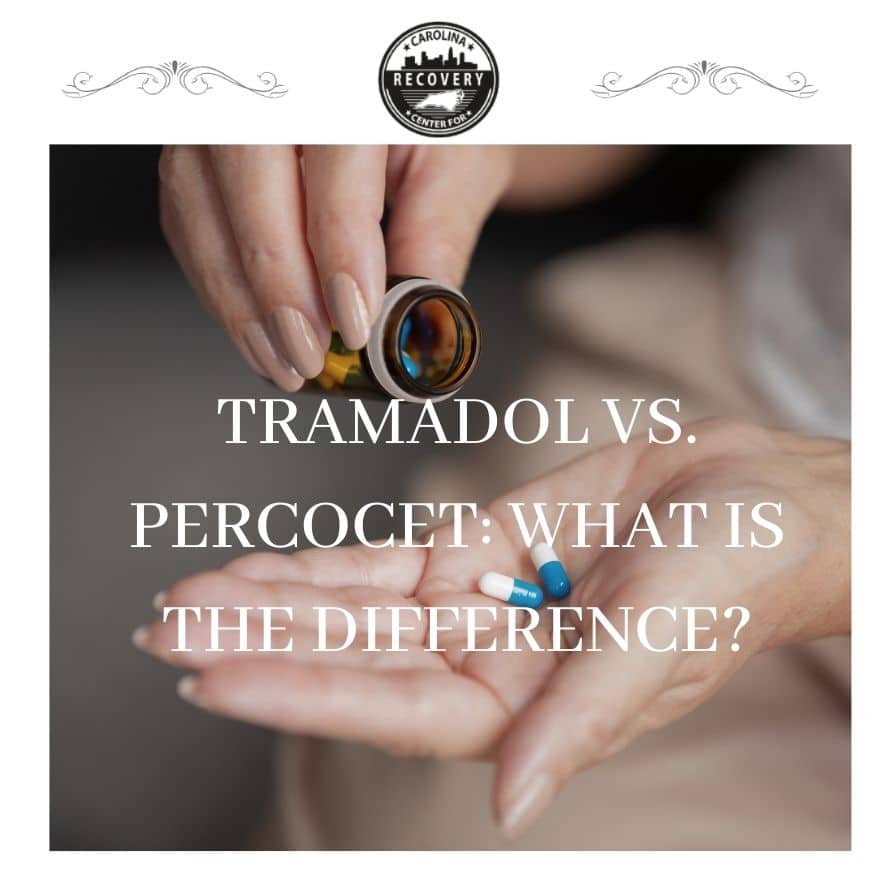Tramadol vs Percocet: What is the Difference?

Medically Verified: 2/1/24
Medical Reviewer
Chief Editor

All of the information on this page has been reviewed and verified by a certified addiction professional.
Tramadol and Percocet are both opioid medications used for pain relief. The main difference between them is their potency. Percocet contains oxycodone and is much stronger than tramadol. As a result, it takes less of the medication to experience effects.
Unfortunately, both tramadol and Percocet are habit-forming and addictive. When abused, these substances can create a euphoric and drowsy high. Because of their addictive nature, they are not intended to be used on a long-term basis.
What is Tramadol?
Tramadol is an opioid pain reliever that is only prescribed when non-opioid agents are ineffective in treating the symptoms of moderate to severe pain. It is sold under the brand names Ultram, Ultram ER, and Conzip. Tramadol is commonly prescribed after procedures or among patients with chronic pain conditions. By changing the way the brain reacts to pain, tramadol is effective in helping patients cope.[2]
While tramadol is effective in managing pain, long-term use or overuse of it can lead to addiction. As a result, tramadol is only intended to be used for short periods.
Common side effects of tramadol include:[2]
- Nausea
- Dry mouth
- Dizziness and drowsiness
- Sedation
- Headaches
- Nervousness
- Indigestion
It is possible to have a severe reaction to tramadol, especially if you are allergic to opioids. If you develop a rash, hives, blisters, chest pain, loss of consciousness, or seizures, contact emergency medical services immediately.
What is Percocet?
Percocet is the brand name for a medication containing oxycodone and acetaminophen (Tylenol). It is only prescribed to individuals experiencing moderate and severe pain. Less potent pain relievers might be tried before Percocet is prescribed.
Percocet contains oxycodone, a powerful and addictive opioid, so it is only recommended for short-term use.
The side effects of Percocet may include:[3]
- Dry mouth
- Stomach pain or nausea
- Drowsiness and dizziness
- Flushing
- Headaches
- Changes in mood
Like tramadol, some people have experienced severe reactions to Percocet, indicating a potential allergy. Contact emergency medical services if you experience changes in heartbeat, agitation, hives, itching, seizures, or difficulty breathing.
What is the Difference Between Tramadol and Percocet?
The main difference between tramadol and Percocet is the potency of the substances. Tramadol is considered a weaker opioid, with properties similar to morphine. On the other hand, Percocet contains oxycodone, one of the most potent prescription opioids available.
Another difference between the two medications is the way they relieve pain. While Percocet relieves pain by attaching to mu-opioid receptors and interrupting pain signals in the brain and spinal cord, tramadol has an additional mechanism of action. In addition to binding to opioid receptors, tramadol also reduces the reuptake of serotonin, a neurotransmitter in the brain that has a role in pain relief.
Naturally, because Percocet is stronger than tramadol, the risk of addiction is also higher. This means you are more likely to become addicted to Percocet than tramadol, making tramadol the preferred method of treatment for pain.
Additionally, because the risk of addiction is different between the two substances, they are scheduled differently. While tramadol is a Schedule IV drug, Percocet is a Schedule II substance with a high-risk classification.[4]
Signs You Are Suffering From an Opioid Addiction
If you have been taking Percocet or tramadol, you might be worried that you have developed an addiction. If you find yourself taking more of either medication than you are prescribed by your doctor, you are more than likely struggling with a substance use disorder.
Other signs that you are addicted to a prescription opioid include:
- Running out of your prescription early
- Going to more than one doctor to receive multiple prescriptions at once (“Doctor shopping”)
- Needing to increase your dose to experience a desired effect
- Continuing to use an opioid longer than you are intended to
- Buying opioids from drug dealers when you run out of your prescription
- Experiencing strong urges or cravings to use opioids
- Dealing with withdrawal symptoms when you stop using an opioid
- Continuing to use opioids despite facing problems at work, home, or school
- Continuing to use opioids despite dealing with physical or mental health effects
Find Help for Tramadol or Percocet Addiction
If you or a loved one abuse tramadol, Percocet, or any other opioid, it’s time to seek help. Opioid addiction can be incredibly difficult to overcome, especially if you are receiving a prescription or suffer from chronic pain. Thankfully, rehab programs like Carolina Center for Recovery can help you learn how to live a substance-free life.
To learn more about our opioid rehab programs, please contact us today.
References:
- The National Institute of Drug Abuse (NIDA): Drug Overdose Death Rates, Retrieved August 2023 From https://nida.nih.gov/research-topics/trends-statistics/overdose-death-rates
- Medline Plus: Tramadol, Retrieved August 2023 From https://medlineplus.gov/druginfo/meds/a695011.html
- The Food and Drug Administration (FDA): Oxycodone and acetaminophen label, Retrieved August 2023 From https://www.accessdata.fda.gov/drugsatfda_docs/label/2006/040330s015,040341s013,040434s003lbl.pdf
- The Drug Enforcement Administration (DEA): Drug Scheduling, Retrieved August 2023 From https://www.dea.gov/drug-information/drug-scheduling

